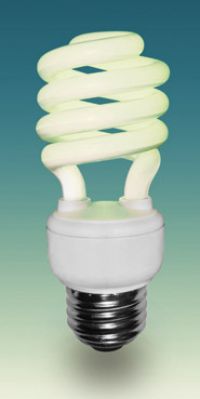Some say banning old-fashioned lightbulbs — the incandescent kind — could be bad for our health, believing a shift to compact fluorescent lights (CFLs) will mean more exposure to mercury, ultra-violet (UV) radiation and electromagnetic fields (EMFs). Unfortunately, it might be this belief that could cause the most harm.
Following the lead of governments around the world, Canada is scheduled to begin to phase out inefficient incandescent bulbs in 2012. Now the federal government says that proposal should wait another two years until they can respond to the perceived health concerns related to CFLs.
This despite studies by Health Canada and other major health organizations that show CFLs do not cause increased health risks from UV radiation or EMFs. According to their website, "Health Canada has studied UV radiation and EMF emission levels from CFLs. The study determined that CFLs, if used as directed, do not currently pose a health hazard to the general population from UV radiations and EMF emission levels."
Both sides of the lightbulb debate — those for scrapping old fashioned incandescents and those that want to keep them — have stated the same goals: protecting public health. So how can we find a common solution? The truth of the matter is that it is the amount of energy we are currently consuming to generate electricity, not lightbulbs, that poses the most serious public health risk.
 Yes, CFLs contain mercury, which is true of regular fluorescent lightbulbs — although CFLs have it in much lower amounts simply because they're smaller. If a bulb is broken or thrown in the trash, it's true that mercury will be released and it is hazardous. Yet, pollution released from coal-fired power plants used to generate electricity releases mercury and other pollutants into the atmosphere in much larger quantities than CFLs ever could.
Yes, CFLs contain mercury, which is true of regular fluorescent lightbulbs — although CFLs have it in much lower amounts simply because they're smaller. If a bulb is broken or thrown in the trash, it's true that mercury will be released and it is hazardous. Yet, pollution released from coal-fired power plants used to generate electricity releases mercury and other pollutants into the atmosphere in much larger quantities than CFLs ever could.
CFLs are three to four times more efficient than regular bulbs, meaning three to four times less power use. Multiply lightbulb use across the country and at least one major coal-fired power plant wouldn't be needed and could be taken offline with a switch to CFLs. So while CFLs do pollute when broken or trashed, our current energy use pollutes much more, not to mention there are simple solutions to ensure proper disposal of CFLs.
We should also keep in mind that pollution saved from power plants doesn't just benefit provinces that use coal for electricity generation. The pollution from these plants crosses borders and, particularly with mercury, it can travel vast distances.
Neither are CFLs the only energy efficient form of lighting. Once incandescent lightbulbs are phased out people will have even more choices for lighting: they can use halogen bulbs or light emitting diodes (LEDs), for example. This is not to mention that with new regulations in place, new lighting technologies are sure to emerge giving people even more choices when it comes to efficient lighting,
To their credit, the federal government has started to regulate the amount of mercury allowed in bulbs and is working with retailers to improve collection and disposal of CFLs. Nonetheless, the government itself estimates that the two-year delay will result in a number of negative consequences on top of air pollution, including:
- 24 billion kilowatt hours of wasted electricity,
- $303 million in extra costs for consumers, and
- 13 million tonnes of unnecessary greenhouse gas emissions.
However trivial lightbulb regulation may seem, the health benefits from energy conservation are anything but. The unfortunate reality is that the government admits that the proposal to delay efficiency regulations has more to do with making critics happy than it does with any real health threat posed from CFLs.
That's why the Pembina Institute has submitted comments to Natural Resources Canada recommending the government stick with its original timeline to phase out incandescent lightbulbs — to do otherwise would be a dim approach to public health in Canada.










